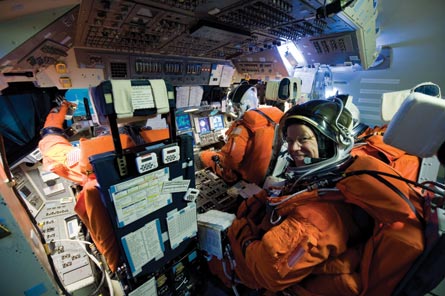 |
|---|
© James Blair/NASAA motion-based Space Shuttle simulator at the Johnson Space Center provides crews with launch and landing practice |
Growing up in the USA in the 1960s I was captivated by the space programme as we raced the Soviet Union to the Moon. Most of my generation can tell you where they were when Neil Armstrong and Buzz Aldrin landed at Tranquility Base on 20 July 1969.
After that, "one giant leap for mankind" and the conclusion of the Moon programme, the Space Shuttle promised to make space missions routine.
The Space Shuttle was the first reusable space vehicle - one that could return to Earth and land like an aircraft. Each orbiter was designed to have a life span of 100 launches. While the planned launch rate was 12 a year, NASA estimated at one point that the vehicles could launch a maximum of 25 missions a year.
The Space Shuttle promised to bring down the cost of space access with unprecedented economies of scale. While it never lofted payloads at its planned rate, the Shuttle has been a great success. Despite the tragic loss of two orbiters and their crews, the Shuttle has put numerous civil and military satellites into orbit. The International Space Station and Hubble Space telescope are two of the Shuttle's brightest success stories.
 |
|---|
Enterprise was the first Space Shuttle, built for flight testing without engines or a functional heat shield. It was intended to be refitted for spaceflight but design changes would have made refitting costly and difficult |
As the Shuttle programme winds down, Flight International was able to sample the atmospheric flight experience of the delta-winged spacecraft in Houston during multi-hour training sessions in two types of simulators on 12 October - a full-motion launch and landing simulator and a fixed-based avionics integration laboratory simulator.
For the recovery/landing phase of Shuttle flight, two programmes stand out as essential to its successful development: the several lifting-body flight programmes and the X-15 hypersonic research programme. The experience gained by flying the numerous lifting bodies in the 1960s and 1970s showed that "wingless" aircraft can be controlled in flight and glided to a safe landing on a runway. The thermal stress environment of hypersonic atmospheric flight, vehicle control schemes as well as descent and landing profiles were all explored by the X-15.
While the Shuttle has a delta wing planform, its design was significantly influenced by the lessons learned from flying lifting-body vehicles.
Landing an unpowered aircraft is routine for a glider pilot. Pilots of single-engined fighters often practise engine-out landing patterns, often called an SFO (simulated flame-out landing). Real dead-stick landings are a rare event, a direct consequence of reliable jet engines and ejection seats.
While Capt Chesley Sullenberger ditched an unpowered US Airlines Airbus A320 in the Hudson river, a dead-stick landing in a transport-class jet aircraft is not even a practised event. Dead-stick landing a Space Shuttle-sized aircraft was uncharted territory. While achievable in theory, NASA set out to quantify the magnitude of the task. Using a Convair CV-990, a Boeing 707-class four-engined jet transport, NASA accomplished Shuttle-like approach and landing trials in a real aircraft. The pattern airspeed for the trials was 210-220kt (390-410km/h), well below the Shuttle's airspeed of around 295kt.
UNPOWERED APPROACH
In an unpowered approach the only energy available to the aircraft is its speed and altitude. The aircraft must have enough energy to reach the desired runway, with an excess of energy desirable. NASA determined there were two possible ways to modulate the aircraft's total energy in relation to the touchdown point: path length variation and lift-to-drag ratio (L/D) modulation.
An accomplished glider pilot uses both methods on a typical approach, judging the turn to the field upon the total energy state. Once on final an aim-point is selected and L/D changed by using the speed brakes to control aircraft speed.
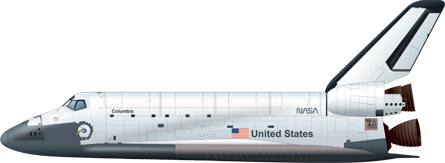 |
|---|
The second to be constructed but the first spaceworthy Shuttle, Columbia launched on 12 April 1981 - the 20th anniversary of the first human spaceflight. It completed 27 missions before breaking up in February 2003 |
For the CV-990 study, NASA used engineering test pilots, two pilots who had flown lifting-body flights, as well as two commercial airline pilots. The limited study, published in October 1971, arrived at some promising conclusions for the nascent Shuttle programme.
Firstly, it found that unpowered approaches for a Shuttle-like aircraft were practical. Secondly, observed touchdown dispersion data supported operations on reasonable-length runways. Thirdly, approach guidance during the final approach phase reduced touchdown dispersion.
Finally, they concluded that high levels of pilot proficiency were not needed to successfully land a Shuttle-like aircraft.
For my familiarisation flight in the simulator, Paul Dye, a human spaceflight lead flight director, acted as my instructor. For the flight we would be flying the software and vehicle properties for the forthcoming STS-133 mission to the International Space Station, which is likely to be the final mission for the Discovery orbiter.
CAB ROTATION
The full motion simulator looks like any of the many simulators I have flown. What is unique is its ability to rotate the cab to stand on end, replicating the vertical launch position.
To get a feel for the size of cockpit of the actual vehicle rather than the purpose-built simulator, I climbed aboard the Shuttle mock-up in NASA's Space Vehicle Mockup Facility, entering via the round crew hatch located on the mid-deck. The mid-deck is used for on-orbit living and storage and usually seats three crew, but an additional three rescue seats can be added to bring the mid-deck's seating up to six.
I used the ladder to climb into the flightdeck area. The flightdeck seats four crew members, the two pilots and two mission specialists. Like the mid-deck, the flightdeck felt crowded. Overall, the cockpit is larger than a Boeing 737, my regular ride.
 |
|---|
© NASAWhat is unique about the shuttle simulator is its ability to rotate the cab to stand on end, replicating the vertical launch position.
|
The forward area of the flightdeck is arranged much like a conventional transport aircraft. There are eight windows for the pilots - three forward and side windows plus an overhead eyebrow window on each side.
Back in the simulator, I manoeuvred around the large centre console and settled into the left commander's seat. The original cockpit had analogue gauges, with a 360° spherical attitude director indicator designed to represent orbital flight. Additionally the several forward panel displays were CRTs.
Current Shuttles have been modified with an improved standard multipurpose electronics display system. Eleven 11in (280mm) LCD displays, with bezel buttons for pilot interface, have been installed. Make no mistake, the avionics have a vintage 1980s feel to them. The display modification merely replaced analogue gauges with digital representations.
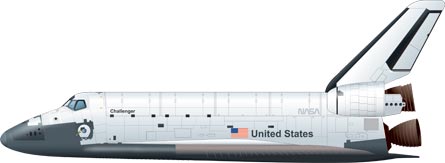 |
|---|
Built as a structural test article, Challenger was rebuilt as OV-099 and became the second Shuttle to go into service on 4 April 1983. Completed nine missions before breaking apart 73s into the launch of its 10th mission |
Interface with ship's computer systems is via push buttons. Selecting display configurations for the various phases of the mission was not intuitive, but a skill mastered through practice. The graphical user interfaces we take for granted now were not state of the art when the Shuttle was developed.
One nice addition to the original cockpit is a small dual-pane head-up display. The HUD looks as if it came out of an early model Boeing F-18 Hornet.
The control stick for the Shuttle is an Apollo-type controller, mounted between the legs on a pedestal. There is no feedback mechanism in the stick, much like that of a fly-by-wire Airbus. For lateral/roll control the stick is articulated below the base of the stick grip.
The pitch axis of the stick is rotated slightly counter clockwise, when viewed from above, to make longitudinal stick inputs feel natural for right-handed actuation. For pitch control, the stick grip rotates about a point about one-third of the way up the grip. During my time in the simulator the control stick felt more like a video game controller than a proper control stick.
Additionally, the stick grip rotates/twists about its base to provide yaw control when on orbit. Conventional rudder pedals for controlling yaw in the atmosphere are provided for both the commander (left seat) and pilot. The Shuttle's flight-control system is essentially a rate command system, releasing the stick causing the craft to hold the existing attitude.
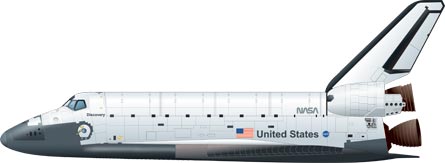 |
|---|
Discovery became the third operational Shuttle to fly on 30 August 1984 and is the oldest of the three still flying. It was chosen for the "return to flight" missions following the losses of Challenger and Columbia |
As on a conventional aircraft, the Shuttle has toe-actuated main wheel brakes. Each pilot also has a speed brake lever, located to the left of their respective seats, to manually control speedbrake deployment.
Once strapped in, I moved my feet to place them on the rudder pedals. Dye suggested that as we would soon be on our backs, that I place my feet against the bottom of the seat for launch. Dye conducted abbreviated pre-launch checks and before I knew it the three Space Shuttle main engines were started.
The Shuttle's ascent into orbit is controlled from the Johnson Space Center, with the astronauts standing by to take manual control if needed. Solid rocket booster ignition was signified by a rattling of the entire simulator cab.
Out of the left-hand side window I watched the launch tower recede as about 7.5 million lb of thrust (33,375kN) lifted the Shuttle off the pad. Initial acceleration was 1.7g straight up. Eighteen seconds after lift-off the Shuttle completed a roll manoeuvre to align it for its down-range trajectory. After 26s the Shuttle was passing through 5,500ft (1,680m) above ground level at a speed of M0.5. Before breaking the sound barrier the main engines were throttled back to about 70% as the Shuttle approached its maximum allowable dynamic pressure limit.
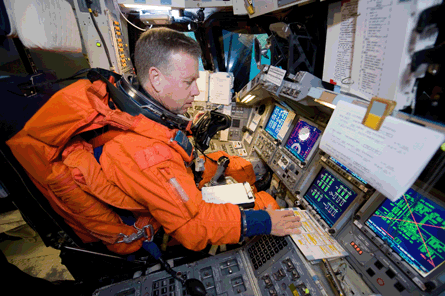 |
|---|
© James Blair/NASA |
Dynamic pressure decreased as the Shuttle climbed into thinner air, and the main engines were throttled back up to about 103%. Mach 1 was reached while passing through 23,000ft, only 43s after launch. Two minutes and 15s after launch the solid rocket boosters separated, and the ride smoothed out.
While camera footage shows the Shuttle's vertical trajectory at lift-off, the trajectory flattens out at high altitude to send it down range. Passing 220,000ft, 2m 47s after launch, we had accelerated to M6.2, or about 6,200ft/s (1,890m/s).
At about 300,000ft and out of the atmosphere, the Shuttle levels out and accelerates down range to attain escape velocity. The main engines are throttled back continuously to main engine cut-off (where the final thrust is about 70% of the starting value) to maintain a 3g acceleration, a vehicle and astronaut comfort limit.
After main engine cut-off and external tank jettison we had reached an altitude of 352,000ft and travelling at M23, where Dye said for practical purposes we were in orbit.
The simulator cannot replicate the high-g loadings for the launch nor the transition to zero g, but I think it safe to say that an actual Shuttle launch must be one heck of a ride.
Our next event in the simulator was the "50K" reset point at the Kennedy Space Center, where I would try my hand at landing the world's worst glider. The Shuttle has a wing span of 78ft, length of 122ft and empty weight of about 78,000kg (172,000lb). Its cranked delta wing has an area of 250m2 (2,690ft2), giving the Shuttle a high wing loading.
The Shuttle's L/D varies from about 1:1 at hypersonic speeds to about 4.5:1 for the landing condition. Flight-control surfaces consist of four elevons on the trailing edge of the wing, a moveable body flap and a rudder/speed brake on the vertical stabiliser. Five general purpose computers, four primary with one back-up, supply commands to the hydraulically actuated control surfaces.
Like the Lockheed Martin F-16, in which I have more than 1,500h, the Shuttle is statically unstable in pitch and a fly-by-wire control system is needed to keep it under control. In an F-16 one wants to be overhead the landing runway, heading in the landing direction, at about 7-10,000ft above the ground.
FLAME-OUT
This is called "High Key" for a 360° overhead flame-out landing pattern. I was fortunate enough once earlier in my career to practise an SFO in a two seat Lockheed F-104. As I can best recall, the desired high-key altitude was about 16,000ft above the ground.
The pacing of the SFO pattern in both the F-16 and F-104 were very similar, despite the much higher altitude required for the F-104. For the Shuttle, high key is at about 80,000ft above the ground.
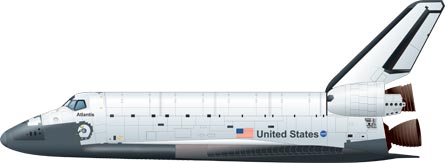 |
|---|
The fourth operational Shuttle constructed by Rockwell, Atlantis has made 32 flights, including its 3 October 1985 maiden voyage. If the planned mission - STS-135 - remains in place, Atlantis will be the last Shuttle to fly |
The 50,000ft reset had the Shuttle upwind of the landing runway, Runway 15 in this case, heading 050° (perpendicular to the runway). While I had performed well over 100 SFOs in the F-16, and one real flame-out landing, I was more than a little curious to see how the Shuttle would fly.
Once the simulator was taken out of freeze mode, I used the guidance cues in the HUD to start a descending left hand turn, at about 45° of bank. A nose low pitch attitude of 20° was needed to hold an equivalent airspeed of about 290kt.
To aid in energy management, the Shuttle has heading alignment circle displayed on the horizontal situation display. Current Shuttle position as well as 20s, 40s and 60s future prediction dots are displayed. The circle is in reality a cone that tightens in diameter as the Shuttle descends. Keeping all three dots on the circle and rolling out aligned with the display's runway indicator should put the Shuttle in a position to safely land on Kennedy's 4,570m runway. I found the guidance cue in the HUD easy to follow, and all three predictor dots falling on the circle.
The initial part of the Shuttle approach is guided using Shuttle positional data. Shuttle inertial position is updated and refined by TACAN and/or GPS inputs. Descending through an altitude about 14,000ft above the ground, approach guidance is provided by a ground-based microwave landing system. HUD guidance symbology changes from a square to a circle to indicate the change in guidance source.
Following the HUD guidance while visually cross checking runway alignment, the Shuttle rolled out on final at about 10,000ft above the ground. The Shuttle was on the 18-19° outer glidepath, with a visual aim point about 9,000ft short of the runway. Throughout the approach, the speed brakes were modulated by the flight-control system to maintain the target airspeed of around 290kt.
At 4,000ft, Dye armed the landing gear for extension. Approaching 3,000ft, two pre-flare cues appeared at the bottom of the HUD. When the cues approached the flightpath marker at about 2,000ft, I initiated the pre-flare to establish the Shuttle on a 1.5° inner glide path. The visual aim point was now the approach end of the runway. At 400ft Dye lowered the landing gear.
Should the primary hydraulic lowering mechanism fail, two sets of pyrotechnics stand by to automatically extend the landing gear. Crossing the threshold at 50ft, slightly higher than the desired 26ft height, I shifted the aim point to the horizon and held it there. The Shuttle continued to slow, and we touched down at an airspeed equivalent to about 200kt.
 |
|---|
Constructed from the fleet's spare parts after the 1986 Challenger disaster, Endeavour first flew on 7 May 1992. It is one of the three Space Shuttles remaining in operation and the final spaceworthy Shuttle NASA built |
Dye deployed the Shuttle's drag chute while I actuated the toe brakes to slow the Shuttle. My pitch rate while lowering the nose to the runway - de-rotation in NASA parlance - was somewhat fast, but within acceptable limits. Slowing through 60kt, Dye released the drag chute, ensuring it did not foul and possibly damage the main engines.
After the first 50K reset, I was able to do three more approaches to Runway 15. The first was another 50K reset, like the first. On this approach I overflared during the transition from the outer to the inner glide path. I was able to step the Shuttle down to the runway, but the touchdown airspeed was slower than desired. During the final portion of the approach, after the pre-flare to touch down, I encountered a bit of pilot-induced oscillation in pitch.
For the Shuttle, the demands of orbital flight and re-entry made handling qualities during the landing phase a lesser concern. Fly-by-wire controls can compensate for inherent design shortcomings, but finding an optimum solution may not be feasible given programmatic schedule and funding constraints. Early in the Shuttle programme, NASA was aware of the pilot-induced oscillation tendency, and efforts to ensure this did not lead to a landing incident concentrated on pilot astronaut training.
The last two approaches at Kennedy were 25K (starting at 25,000ft) resets, allowing me to concentrate on my pre-flare technique. During these I refined my pre-flare pull technique, striving to attain the desired 1.3-1.4g pull.
Additionally, I was also able to work on my de-rotation technique, to more gently set the Shuttle's nose on the runway. The last of these two approaches was even more challenging as the automatic speedbrake function was turned off. A "speedbrake director" display is provided in both the HUD and the head-down display. During the approach I found speedbrake position lagged my commands by a significant amount.
SAFE LANDING
Despite my less than optimal speedbrake control efforts, we were nevertheless able to safely land the Shuttle and bring it to a stop on the runway.
The four simulated approaches gave me a unique insight into the challenges faced by pilot astronauts after being in orbit for several days. In many ways, techniques for landing the Shuttle were similar to those for the F-16. Once the final aim point and landing attitude were set, it was best to back out of the control loop and let inertia take its course.
Source: Flight International



















